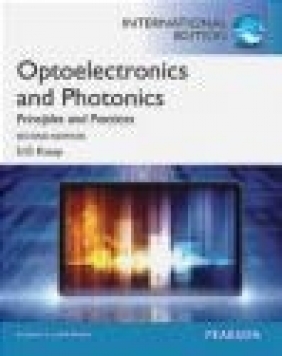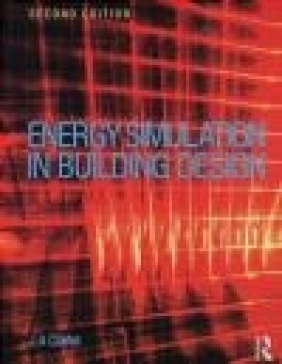Optoelectronics
Safa Kasap
Optoelectronics
Safa Kasap
- Producent: Pearson
- Rok produkcji: 2013
- ISBN: 9780273774174
- Ilość stron: 544
- Oprawa: Miękka
Niedostępna
Opis: Optoelectronics - Safa Kasap
For one-semester, undergraduate-level courses in Optoelectronics and Photonics, in the departments of electrical engineering, engineering physics, and materials science and engineering. This text takes a fresh look at the enormous developments in electo-optic devices and associated materials-such as Pockels (Lithium Niobate) modulators.Chapter 1 Wave Nature of Light 3 1.1 Light Waves in a Homogeneous Medium 3 A. Plane Electromagnetic Wave 3 B. Maxwell's Wave Equation and Diverging Waves 6 Example 1.1.1 A diverging laser beam 10 1.2 Refractive Index and Dispersion 10 Example 1.2.1 Sellmeier equation and diamond 13 Example 1.2.2 Cauchy equation and diamond 14 1.3 Group Velocity and Group Index 14 Example 1.3.1 Group velocity 17 Example 1.3.2 Group velocity and index 17 Example 1.3.3 Group and phase velocities 18 1.4 Magnetic Field, Irradiance, and Poynting Vector 18 Example 1.4.1 Electric and magnetic fields in light 21 Example 1.4.2 Power and irradiance of a Gaussian beam 21 1.5 Snell's Law and Total Internal Reflection (TIR) 22 Example 1.5.1 Beam displacement 25 1.6 Fresnel's Equations 26 A. Amplitude Reflection and Transmission Coefficients (r and t ) 26 B. Intensity, Reflectance, and Transmittance 32 C. Goos-H(t)nchen Shift and Optical Tunneling 33 Example 1.6.1 Reflection of light from a less dense medium (internal reflection) 35 Example 1.6.2 Reflection at normal incidence, and internal and external reflection 36 Example 1.6.3 Reflection and transmission at the Brewster angle 37 1.7 Antireflection Coatings and Dielectric Mirrors 38 A. Antireflection Coatings on Photodetectors and Solar Cells 38 Example 1.7.1 Antireflection coating on a photodetector 39 B. Dielectric Mirrors and Bragg Reflectors 40 Example 1.7.2 Dielectric mirror 42 1.8 Absorption of Light and Complex Refractive Index 43 Example 1.8.1 Complex refractive index of InP 46 Example 1.8.2 Reflectance of CdTe around resonance absorption 47 1.9 Temporal and Spatial Coherence 47 Example 1.9.1 Coherence length of LED light 50 1.10 Superposition and Interference of Waves 51 1.11 Multiple Interference and Optical Resonators 53 Example 1.11.1 Resonator modes and spectral width of a semiconductor Fabry-Perot cavity 57 1.12 Diffraction Principles 58 A. Fraunhofer Diffraction 58 Example 1.12.1 Resolving power of imaging systems 63 B. Diffraction Grating 64 Example 1.12.2 A reflection grating 67 Additional Topics 68 1.13 Interferometers 68 1.14 Thin Film Optics: Multiple Reflections in Thin Films 70 Example 1.14.1 Thin film optics 72 1.15 Multiple Reflections in Plates and Incoherent Waves 73 1.16 Scattering of Light 74 1.17 Photonic Crystals 76 Questions and Problems 82 Chapter 2 Dielectric Waveguides and Optical Fibers 95 2.1 Symmetric Planar Dielectric Slab Waveguide 95 A. Waveguide Condition 95 B. Single and Multimode Waveguides 100 C. TE and TM Modes 100 Example 2.1.1 Waveguide modes 101 Example 2.1.2 V-number and the number of modes 102 Example 2.1.3 Mode field width, 2wo 103 2.2 Modal and Waveguide Dispersion in Planar Waveguides 104 A. Waveguide Dispersion Diagram and Group Velocity 104 B. Intermodal Dispersion 105 C. Intramodal Dispersion 106 2.3 Step-Index Optical Fiber 107 A. Principles and Allowed Modes 107 Example 2.3.1 A multimode fiber 112 Example 2.3.2 A single-mode fiber 112 B. Mode Field Diameter 112 Example 2.3.3 Mode field diameter 113 C. Propagation Constant and Group Velocity 114 Example 2.3.4 Group velocity and delay 115 D. Modal Dispersion in Multimode Step-Index Fibers 116 Example 2.3.5 A multimode fiber and dispersion 116 2.4 Numerical Aperture 117 Example 2.4.1 A multimode fiber and total acceptance angle 118 Example 2.4.2 A single-mode fiber 118 2.5 Dispersion In Single-Mode Fibers 119 A. Material Dispersion 119 B. Waveguide Dispersion 120 C. Chromatic Dispersion 122 D. Profile and Polarization Dispersion Effects 122 Example 2.5.1 Material dispersion 124 Example 2.5.2 Material, waveguide, and chromatic dispersion 125 Example 2.5.3 Chromatic dispersion at different wavelengths 125 Example 2.5.4 Waveguide dispersion 126 2.6 Dispersion Modified Fibers and Compensation 126 A. Dispersion Modified Fibers 126 B. Dispersion Compensation 128 Example 2.6.1 Dispersion compensation 130 2.7 Bit Rate, Dispersion, and Electrical and Optical Bandwidth 130 A. Bit Rate and Dispersion 130 B. Optical and Electrical Bandwidth 133 Example 2.7.1 Bit rate and dispersion for a single-mode fiber 135 2.8 The Graded Index (GRIN) Optical Fiber 135 A. Basic Properties of GRIN Fibers 135 B. Telecommunications 139 Example 2.8.1 Dispersion in a graded index fiber and bit rate 140 Example 2.8.2 Dispersion in a graded index fiber and bit rate 141 2.9 Attenuation in Optical Fibers 142 A. Attenuation Coefficient and Optical Power Levels 142 Example 2.9.1 Attenuation along an optical fiber 144 B. Intrinsic Attenuation in Optical Fibers 144 C. Intrinsic Attenuation Equations 146 Example 2.9.2 Rayleigh scattering equations 147 D. Bending losses 148 Example 2.9.3 Bending loss for SMF 151 2.10 Fiber Manufacture 152 A. Fiber Drawing 152 B. Outside Vapor Deposition 153 Example 2.10.1 Fiber drawing 155 Additional Topics 155 2.11 Wavelength Division Multiplexing: WDM 155 2.12 Nonlinear Effects in Optical Fibers and DWDM 157 2.13 Bragg Fibers 159 2.14 Photonic Crystal Fibers-Holey Fibers 160 2.15 Fiber Bragg Gratings and Sensors 163 Example 2.15.1 Fiber Bragg grating at 1550 nm 167 Questions and Problems 167 Chapter 3 Semiconductor Science and Light-Emitting Diodes 179 3.1 Review of Semiconductor Concepts and Energy Bands 179 A. Energy Band Diagrams, Density of States, Fermi-Dirac Function and Metals 179 B. Energy Band Diagrams of Semiconductors 182 3.2 Semiconductor Statistics 184 3.3 Extrinsic Semiconductors 187 A. n-Type and p-Type Semiconductors 187 B. Compensation Doping 190 C. Nondegenerate and Degenerate Semiconductors 191 E. Energy Band Diagrams in an Applied Field 192 Example 3.3.1 Fermi levels in semiconductors 193 Example 3.3.2 Conductivity of n-Si 193 3.4 Direct and Indirect Bandgap Semiconductors: E-k Diagrams 194 3.5 pn Junction Principles 198 A. Open Circuit 198 B. Forward Bias and the Shockley Diode Equation 201 C. Minority Carrier Charge Stored in Forward Bias 206 D. Recombination Current and the Total Current 206 3.6 pn Junction Reverse Current 209 3.7 pn Junction Dynamic Resistance and Capacitances 211 A. Depletion Layer Capacitance 211 B. Dynamic Resistance and Diffusion Capacitance for Small Signals 213 3.8 Recombination Lifetime 214 A. Direct Recombination 214 B. Indirect Recombination 216 Example 3.8.1 A direct bandgap pn junction 216 3.9 pn Junction Band Diagram 218 A. Open Circuit 218 B. Forward and Reverse Bias 220 Example 3.9.1 The built-in voltage from the band diagram 221 3.10 Heterojunctions 222 3.11 Light-Emitting Diodes: Principles 224 A. Homojunction LEDs 224 B. Heterostructure High Intensity LEDs 226 C. Output Spectrum 228 Example 3.11.1 LED spectral linewidth 231 Example 3.11.2 LED spectral width 232 Example 3.11.3 Dependence of the emission peak and linewidth on temperature 233 3.12 Quantum Well High Intensity LEDs 233 Example 3.12.1 Energy levels in the quantum well 236 3.13 LED Materials and Structures 237 A. LED Materials 237 B. LED Structures 238 Example 3.13.1 Light extraction from a bare LED chip 241 3.14 LED Efficiencies and Luminous Flux 242 Example 3.14.1 LED efficiencies 244 Example 3.14.2 LED brightness 245 3.15 Basic LED Characteristics 245 3.16 LEDs for Optical Fiber Communications 246 3.17 Phosphors and White LEDs 249 Additional Topics 251 3.18 LED Electronics 251 Questions and Problems 254 Chapter 4 Stimulated Emission Devices: Optical Amplifiers and Lasers 265 4.1 Stimulated Emission, Photon Amplification, and Lasers 265 A. Stimulated Emission and Population Inversion 265 B. Photon Amplification and Laser Principles 266 C. Four-Level Laser System 269 4.2 Stimulated Emission Rate and Emission Cross-Section 270 A. Stimulated Emission and Einstein Coefficients 270 Example 4.2.1 Minimum pumping power for three-level laser systems 272 B. Emission and Absorption Cross-Sections 273 Example 4.2.2 Gain coefficient in a Nd3 -doped glass fiber 275 4.3 Erbium-Doped Fiber Amplifiers 276 A. Principle of Operation and Amplifier Configurations 276 B. EDFA Characteristics, Efficiency, and Gain Saturation 280 Example 4.3.1 An erbium-doped fiber amplifier 283 C. Gain-Flattened EDFAs and Noise Figure 284 4.4 Gas Lasers: The He-Ne Laser 287 Example 4.4.1 Efficiency of the He-Ne laser 290 4.5 The Output Spectrum of a Gas Laser 290 Example 4.5.1 Doppler broadened linewidth 293 4.6 Laser Oscillations: Threshold Gain Coefficient and Gain Bandwidth 295 A. Optical Gain Coefficient g 295 B. Threshold Gain Coefficient gth and Output Power 296 Example 4.6.1 Threshold population inversion for the He-Ne laser 299 C. Output Power and Photon Lifetime in the Cavity 299 Example 4.6.2 Output power and photon cavity lifetime Tph 301 D. Optical Cavity, Phase Condition, Laser Modes 301 4.7 Broadening of the Optical Gain Curve and Linewidth 303 4.8 Pulsed Lasers: Q-Switching and Mode Locking 307 A. Q-Switching 307 B. Mode Locking 310 4.9 Principle of the Laser Diode28 311 4.10 Heterostructure Laser Diodes 315 Example 4.10.1 Modes in a semiconductor laser and the optical cavity length 320 4.11 Quantum Well Devices 321 Example 4.11.1 A GaAs quantum well 323 4.12 Elementary Laser Diode Characteristics 324 Example 4.12.1 Laser output wavelength variation with temperature 330 Example 4.12.2 Laser diode efficiencies for a sky-blue LD 330 Example 4.12.3 Laser diode efficiencies 331 4.13 Steady State Semiconductor Rate Equations: The Laser Diode Equation 332 A. Laser Diode Equation 332 B. Optical Gain Curve, Threshold, and Transparency Conditions 335 Example 4.13.1 Threshold current and optical output power from a Fabry-Perot heterostructure laser diode 336 4.14 Single Frequency Semiconductor Lasers 338 A. Distributed Bragg Reflector LDs 338 B. Distributed Feedback LDs 339 C. External Cavity LDs 342 Example 4.14.1 DFB LD wavelength 344 4.15 Vertical Cavity Surface Emitting Lasers36 344 4.16 Semiconductor Optical Amplifiers 348 Additional Topics 350 4.17 Superluminescent and Resonant Cavity Leds: SLD and Rcled 350 4.18 Direct Modulation of Laser Diodes 351 4.19 Holography 354 Questions and Problems 357 Chapter 5 Photodetectors and Image Sensors 365 5.1 Principle of the pn Junction Photodiode 365 A. Basic Principles 365 B. Energy Band Diagrams and Photodetection Modes 367 C. Current-Voltage Convention and Modes of Operation 369 5.2 Shockley-Ramo Theorem and External Photocurrent 370 5.3 Absorption Coefficient and Photodetector Materials 372 5.4 Quantum Efficiency and Responsivity 375 Example 5.4.1 Quantum efficiency and responsivity 378 Example 5.4.2 Maximum quantum efficiency 379 5.5 The pin Photodiode 379 Example 5.5.1 Operation and speed of a pin photodiode 383 Example 5.5.2 Photocarrier Diffusion in a pin photodiode 383 Example 5.5.3 Responsivity of a pin photodiode 384 Example 5.5.4 Steady state photocurrent in the pin photodiode 385 5.6 Avalanche Photodiode 386 A. Principles and Device Structures 386 Example 5.6.1 InGaAs APD responsivity 390 Example 5.6.2 Silicon APD 390 B. Impact Ionization and Avalanche Multiplication 390 Example 5.6.3 Avalanche multiplication in Si APDs 392 5.7 Heterojunction Photodiodes 393 A. Separate Absorption and Multiplication APD 393 B. Superlattice APDs 395 5.8 Schottky Junction Photodetector 397 5.9 Phototransistors 401 5.10 Photoconductive Detectors and Photoconductive Gain 402 5.11 Basic Photodiode Circuits 405 5.12 Noise in Photodetectors 408 A. The pn Junction and pin Photodiodes 408 Example 5.12.1 NEP of a Si pin photodiode 412 Example 5.12.2 Noise of an ideal photodetector 412 Example 5.12.3 SNR of a receiver 413 B. Avalanche Noise in the APD 414 Example 5.12.4 Noise in an APD 414 5.13 Image Sensors 415 A. Basic Principles 415 B. Active Matrix Array and CMOS Image Sensors 417 C. Charge-Coupled Devices 419 Additional Topics 421 5.14 Photovoltaic Devices: Solar Cells 421 A. Basic Principles 421 B. Operating Current and Voltage, and Fill Factor 423 C. Equivalent Circuit of a Solar Cell 424 D. Solar Cell Structures and Efficiencies 426 Example 5.14.1 Solar cell driving a load 428 Example 5.14.2 Open circuit voltage and short circuit current 429 Questions and Problems 429 Chapter 6 Polarization and Modulation of Light 441 6.1 Polarization 441 A. State of Polarization 441 Example 6.1.1 Elliptical and circular polarization 444 B. Malus's Law 444 6.2 Light Propagation in an Anisotropic Medium: Birefringence 445 A. Optical Anisotropy 445 B. Uniaxial Crystals and Fresnel's Optical Indicatrix 447 C. Birefringence of Calcite 450 D. Dichroism 451 6.3 Birefringent Optical Devices 452 A. Retarding Plates 452 Example 6.3.1 Quartz-half wave plate 453 Example 6.3.2 Circular polarization from linear polarization 454 B. Soleil-Babinet Compensator 454 C. Birefringent Prisms 455 6.4 Optical Activity and Circular Birefringence 456 6.5 Liquid Crystal Displays 458 6.6 Electro-Optic Effects 462 A. Definitions 462 B. Pockels Effect 463 Example 6.6.1 Pockels Cell Modulator 468 C. Kerr Effect 468 Example 6.6.2 Kerr Effect Modulator 470 6.7 Integrated Optical Modulators 470 A. Phase and Polarization Modulation 470 B. Mach-Zehnder Modulator 471 C. Coupled Waveguide Modulators 473 Example 6.7.1 Modulated Directional Coupler 476 6.8 Acousto-Optic Modulator 476 A. Photoelastic Effect and Principles 476 B. Acousto-Optic Modulators 478 Example 6.8.1 AO Modulator 483 6.9 Faraday Rotation and Optical Isolators 483 Example 6.9.1 Faraday rotation 484 6.10 Nonlinear Optics and Second Harmonic Generation 485 Additional Topics 489 6.11 Jones Vectors 489 Questions and Problems 490 Appendices Appendix A Gaussian Distribution 498 Appendix B Solid Angles 500 Appendix C Basic Radiometry and Photometry 502 Appendix D Useful Mathematical Formulae 505 Appendix E Notation and Abbreviations 507 Index 519
Producent:
GPSR Pearson Central Europe Sp. z o.o.
ul. Szamocka 8
01-748 Warszawa (PL)
tel: 459 596 060
email: [email protected]
Szczegóły: Optoelectronics - Safa Kasap
Tytuł: Optoelectronics
Autor: Safa Kasap
Producent: Pearson
ISBN: 9780273774174
Rok produkcji: 2013
Ilość stron: 544
Oprawa: Miękka
Waga: 0.67 kg





























